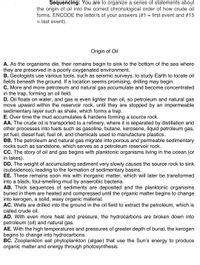
Applications and Investigations in Earth Science (9th Edition)
9th Edition
ISBN: 9780134746241
Author: Edward J. Tarbuck, Frederick K. Lutgens, Dennis G. Tasa
Publisher: PEARSON
expand_more
expand_more
format_list_bulleted
Question

Transcribed Image Text:Sequencing: You are to organize a series of statements about
the origin of oil into the correct chronological order of how crude oil
forms. ENCODE the letter/s of your answers (#1 = first event and #15
= last event).
Origin of Oil
A. As the organisms die, their remains begin to sink to the bottom of the sea where
they are preserved in a poorly oxygenated environment.
B. Geologists use various tools, such as seismic surveys, to study Earth to locate oil
fields beneath the ground. If a location seems promising, drilling may begin.
C. More and more petroleum and natural gas accumulate and become concentrated
in the trap, forming an oil field.
D. Oil floats on water, and gas is even lighter than oil, so petroleum and natural gas
move upward within the reservoir rock, until they are stopped by an impermeable
sedimentary layer such as shale, which forms a trap.
E. Over time the mud accumulates & hardens forming a source rock.
AA. The crude oil is transported to a refinery, where it is separated by distillation and
other processes into fuels such as gasoline, butane, kerosene, liquid petroleum gas,
jet fuel, diesel fuel, fuel oil, and chemicals used to manufacture plastics.
BB. The petroleum and natural gas migrate into porous and permeable sedimentary
rocks such as sandstone, which serves as a petroleum reservoir rock.
CC. The story of oil and gas begins with planktonic organisms living in the ocean (or
in lakes).
DD. The weight of accumulating sediment very slowly causes the source rock to sink
(subsidence), leading to the formation of sedimentary basins.
EE. These remains soon mix with inorganic matter, which will later be transformed
into a black, foul-smelling mud by anaerobic bacteria.
AB. Thick sequences of sediments are deposited and the planktonic organisms
buried in them are heated and compressed until the organic matter begins to change
into kerogen, a solid, waxy organic material.
AC. Wells are drilled into the ground in the oil field to extract the petroleum, which is
called crude oil.
AD. With even more heat and pressure, the hydrocarbons are broken down into
petroleum (oil) and natural gas.
AE. With the high temperatures and pressures of greater depth of burial, the kerogen
begins to change into hydrocarbons.
BC. Zooplankton eat phytoplankton (algae) that use the Sun's energy to produce
organic matter and energy through photosynthesis.
Expert Solution
This question has been solved!
Explore an expertly crafted, step-by-step solution for a thorough understanding of key concepts.
This is a popular solution
Trending nowThis is a popular solution!
Step by stepSolved in 2 steps

Knowledge Booster
Recommended textbooks for you
 Applications and Investigations in Earth Science ...Earth ScienceISBN:9780134746241Author:Edward J. Tarbuck, Frederick K. Lutgens, Dennis G. TasaPublisher:PEARSON
Applications and Investigations in Earth Science ...Earth ScienceISBN:9780134746241Author:Edward J. Tarbuck, Frederick K. Lutgens, Dennis G. TasaPublisher:PEARSON Exercises for Weather & Climate (9th Edition)Earth ScienceISBN:9780134041360Author:Greg CarbonePublisher:PEARSON
Exercises for Weather & Climate (9th Edition)Earth ScienceISBN:9780134041360Author:Greg CarbonePublisher:PEARSON Environmental ScienceEarth ScienceISBN:9781260153125Author:William P Cunningham Prof., Mary Ann Cunningham ProfessorPublisher:McGraw-Hill Education
Environmental ScienceEarth ScienceISBN:9781260153125Author:William P Cunningham Prof., Mary Ann Cunningham ProfessorPublisher:McGraw-Hill Education Earth Science (15th Edition)Earth ScienceISBN:9780134543536Author:Edward J. Tarbuck, Frederick K. Lutgens, Dennis G. TasaPublisher:PEARSON
Earth Science (15th Edition)Earth ScienceISBN:9780134543536Author:Edward J. Tarbuck, Frederick K. Lutgens, Dennis G. TasaPublisher:PEARSON Environmental Science (MindTap Course List)Earth ScienceISBN:9781337569613Author:G. Tyler Miller, Scott SpoolmanPublisher:Cengage Learning
Environmental Science (MindTap Course List)Earth ScienceISBN:9781337569613Author:G. Tyler Miller, Scott SpoolmanPublisher:Cengage Learning Physical GeologyEarth ScienceISBN:9781259916823Author:Plummer, Charles C., CARLSON, Diane H., Hammersley, LisaPublisher:Mcgraw-hill Education,
Physical GeologyEarth ScienceISBN:9781259916823Author:Plummer, Charles C., CARLSON, Diane H., Hammersley, LisaPublisher:Mcgraw-hill Education,

Applications and Investigations in Earth Science ...
Earth Science
ISBN:9780134746241
Author:Edward J. Tarbuck, Frederick K. Lutgens, Dennis G. Tasa
Publisher:PEARSON

Exercises for Weather & Climate (9th Edition)
Earth Science
ISBN:9780134041360
Author:Greg Carbone
Publisher:PEARSON

Environmental Science
Earth Science
ISBN:9781260153125
Author:William P Cunningham Prof., Mary Ann Cunningham Professor
Publisher:McGraw-Hill Education

Earth Science (15th Edition)
Earth Science
ISBN:9780134543536
Author:Edward J. Tarbuck, Frederick K. Lutgens, Dennis G. Tasa
Publisher:PEARSON

Environmental Science (MindTap Course List)
Earth Science
ISBN:9781337569613
Author:G. Tyler Miller, Scott Spoolman
Publisher:Cengage Learning

Physical Geology
Earth Science
ISBN:9781259916823
Author:Plummer, Charles C., CARLSON, Diane H., Hammersley, Lisa
Publisher:Mcgraw-hill Education,